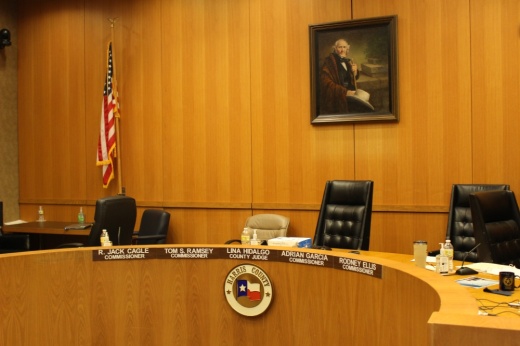Senate Bill 2, which took full effect in January 2020, requires a city or county to hold an election if it proposes an increase in the tax rate over 3.5% from the previous year. According to prior Community Impact Newspaper reporting, the county’s overall property tax rate has decreased each year since 2019; the approved overall tax rate for fiscal year 2021-22 was $0.58135 per $100 valuation—a 2.97% decrease from the rate for fiscal year 2020-2021.
OMB Executive Director Daniel Ramos said a vote to propose a tax rate would likely occur Sept. 13, setting the stage for debate among the commissioners to propose rates between the no-new-revenue rate—the rate a county would need to raise the same amount of property tax revenue as the previous year—and the voter-approval rate.
The county would automatically adopt the no-new-revenue rate if a situation similar to the one in 2019 arose when then-Precinct 3 Commissioner Steve Radack and Precinct 4 Commissioner Jack Cagle did not appear in court to vote on the majority’s proposed tax increases.
Differing deficits
According to Ramos, adopting a no-new-revenue rate would leave the county with anywhere from a $107 million to $155 million deficit in its operating budget, depending on the county’s interpretation of SB 2.
In one interpretation, property values under dispute are excluded from the amount the county can tax, leading to the larger $155 million deficit for the no-new-revenue rate and a $94 million deficit for the voter-approval rate.
In the other—which Ramos said other large counties have adopted—the total appraised value from an appraisal district is based on a five-year rolling average of property values and, in turn, excludes just 10%-12% of the disputed property values. The latter interpretation gives the county around $47 million more to work with and an accompanying $107 million deficit with the no-new-revenue rate, according to Ramos. He did not provide an estimated deficit for this interpretation using the voter-approval rate during the court session.
To make up for the deficit, Ramos said budget cuts could come from areas such as employee benefits packages, scrapping vacant positions and new programming across all departments.
“A lot of things are going to have to be on the table,” Ramos said. “I think it would be fair to say that all departments would have some level of cut. ... I don’t think that there would be a department that would be spared.”
Commissioner insights
The commissioners have not begun the process for proposing a tax rate. Tax rate discussions lasted for less than 15 minutes of the eight-hour Aug. 2 meeting, as much of the time was dedicated to the $1.2 billion bond, which commissioners will vote to put on the ballot during a special session on Aug. 18.
But during the Aug. 2 meeting, Precinct 1 Commissioner Rodney Ellis said budget cuts stemming from a deficit would disproportionately impact those working in public safety, especially if benefits packages were on the table.
In documentation from the OMB for the fiscal year 2023 planning budget, $1.38 billion out of $2.15 billion fell under the OMB’s category of “justice and safety”, with close to 80% of the $1.38 billion going towards detention facilities, sheriff patrol, constables, the district attorney and indigent defense.
Precinct 2 Commissioner Adrian Garcia said in an email he believes a no-new-revenue rate puts the public in danger and could force hiring freezes in law enforcement.
“We can continue to find compromise, cut the tax rate as we have for each year I’ve been in office and keep critical services in place,” Garcia said. “Or county services will be decimated, with the public paying the highest price.”
Although Cagle said he would not make an advanced statement on what tax rate he favors or how he would vote, he told Community Impact Newspaper the debate would center around whether this was the right time to increase taxes on the public.
“If you’re going to raise taxes on the public, you need to have a compelling reason why,” Cagle said. “The taxpayers have all had to tighten their belts. Why shouldn’t government do the same?”
Cagle said he believes county government has “exploded in size” in the last three years, stating that expanded government and programs have left the county in this position.
“It’s the teenage kid that got the credit card, maxed it out, and now needs mom and dad to come in and give them more money,” Cagle said. “I don’t think the public needs to give us more money just because the majority of this court has bloated the size of county government.”
Ellis said in an email he believes the county needs resources to continue its work on public health, environmental protection, housing and the justice system.
“We’ve already had to cut services because of the revenue cap the state has imposed on us,” Ellis wrote. “The proposed no-new-revenue rate ... is a dangerous political stunt that will result in real-world consequences for many in our community who are already hurting.”
Amery Reid, director of communications for Precinct 3 Commissioner Tom Ramsey, said in an email Ramsey wanted to get through budget discussions before commenting on a tax rate vote.
Although Ramos said the estimated deficits are small relative to the county’s overall budget, he would still need to make recommendations for cuts.
“My concern isn’t necessarily next year—it’s the next five years,” Ramos said. “We have revenue restraints and we have spending minimums, and those things are going to collide.”





